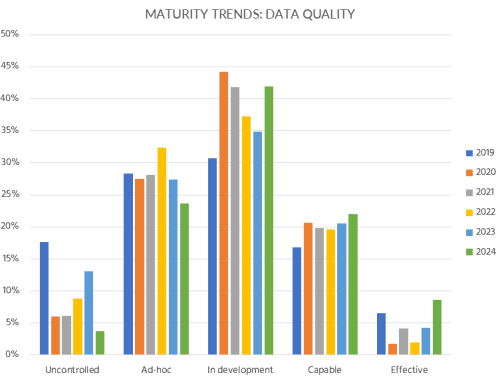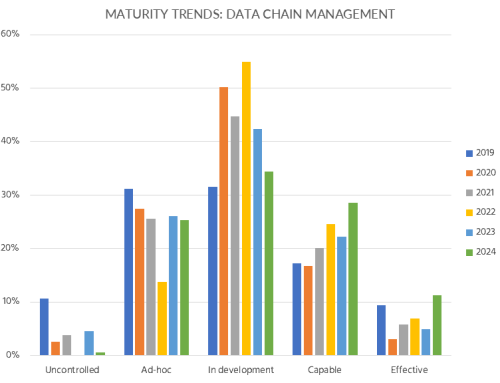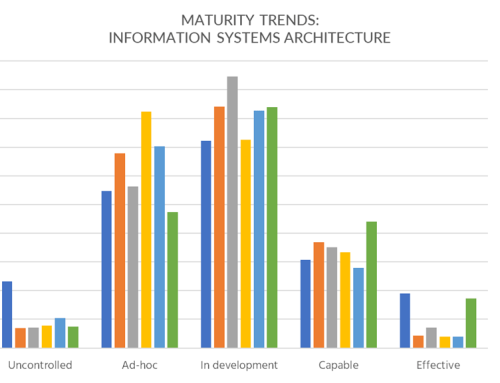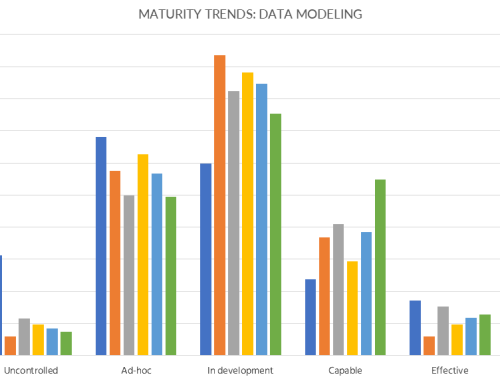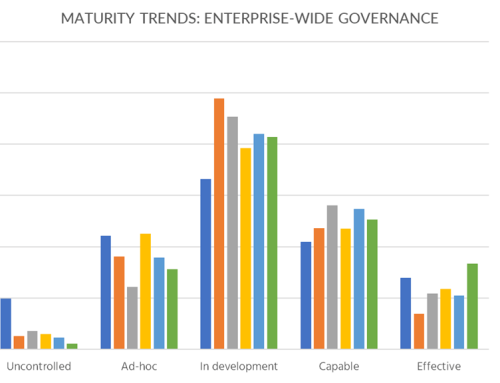This article explores data management maturity trends from 2019 till 2024.
This is the first article in the series Tracking Data Management Maturity: A Five-Year Perspective (2019–2024).
The goal of this article is to establish a common foundation for interpreting the trends presented throughout the series and to frame how data management maturity is assessed across different organizational contexts.
To lay the foundation for understanding both the approach and the outcomes of the observed trends in data management maturity, this article will:
- Discuss the core concepts of the data management (DM) capability and the proposed approach to assessing its maturity
- Compare maturity assessment approaches used in three widely recognized industry guidelines: DAMA-DMBOK2, DCAM®, and CDMC™
- Demonstrate how the O.R.A.N.G.E. Data Management Framework can be used to measure DM maturity
- Present five-year maturity trends for the overall data management capability and its constituent components
Let’s begin by introducing the key concepts.
Aligning Foundational Concepts
The Data Management Capability
The O.R.A.N.G.E. Data Management Framework (DMF) defines the data management (DM) capability as follows:
To create a method for measuring the maturity of the DM capability, it’s essential to first align on a common understanding of what constitutes a business capability.
Two widely adopted business architecture guidelines—the TOGAF® Standard and BIZBOK—use a shared definition proposed initially by Ulrich Homann in his 2006 paper A Business-Oriented Foundation for Service Orientation:
“A business capability is a particular ability or capacity that a business may possess or exchange to achieve a specific purpose or outcome.”
While useful, this definition introduces a challenge: it can lead to different interpretations of what a capability is, due to the distinct meanings of the terms “purpose” and “outcome.”
Let’s take a closer look at the difference:
- Purpose in a business context may refer to:
- The reason something exists or is performed
- An intended or desired result (i.e., a goal)
- Outcome may be interpreted as:
- A final product, result, or consequence
- A conclusion reached through a logical process
A business capability describes what the organization does to achieve a goal (its purpose) and/or to deliver a defined result (its outcome). To understand how a capability achieves these goals, it must be operationalized.
The O.R.A.N.G.E. DMF breaks down a business capability into six key components needed to deliver its outcomes:
- Required artifacts (inputs and outputs)
- Processes
- Policies
- Roles
- IT tools
- Other supporting resources
With these components defined, we can now turn to the question: How can we assess the maturity of the data management capability?
Defining a DM Maturity
Building on the previous definitions, we can conclude that the maturity of the data management (DM) capability can be assessed either at the level of its purpose (the reason it exists) or its outcome (the result it delivers).
To illustrate this distinction, let’s use the example of the data quality (DQ) capability.
Goal
One typical goal for data quality might be:
Ensure that critical data is fit for purpose and trusted for decision-making and operations.
While this goal is essential, it cannot serve as a direct measurement criterion—it’s too abstract and needs to be broken down further to become measurable.
Outcome
Defining DM maturity based on outcomes provides a practical path to breaking goals into measurable criteria. Continuing with the data quality example, we might identify the following outcomes that indicate the goal has been achieved:
- Consistent, accurate, and complete data across key systems
- Early detection and resolution of data issues
- Increased stakeholder trust and reduced operational risk
These outcomes point to concrete indicators that can be measured. For instance:
- The alignment of actual data quality with defined requirements
- The efficiency of issue management processes
- Stakeholder satisfaction with data reliability
Each of these can form the basis for defining key performance indicators (KPIs) that support capability performance management. However, linking a specific goal to a corresponding set of outcomes remains an open challenge. As of now, there is no standardized rule or method for establishing this link.
Capability Components and Items
Different industry guidelines define various sets of capability components. As noted earlier, the O.R.A.N.G.E. Data Management Framework recommends seven key components:
- Output
- Input
- Process or procedure
- Regulation (e.g., policy or standard)
- Role
- IT tool
- Other resources
Maturity assessment focuses on evaluating the existence and level of development of these components and their underlying items. For example, the presence of “data quality regulations” might serve as a maturity criterion. A more detailed evaluation could include specific artifacts such as:
- Data quality requirements
- Business rules for DQ
- Data profiling reports
- Issue logs
These items offer a tangible way to assess the maturity of the capability at different levels of granularity.
Next, we’ll briefly examine how several leading industry frameworks structure their maturity models.
Table 1 summarizes how these frameworks define capability-related objects for measurement purposes.
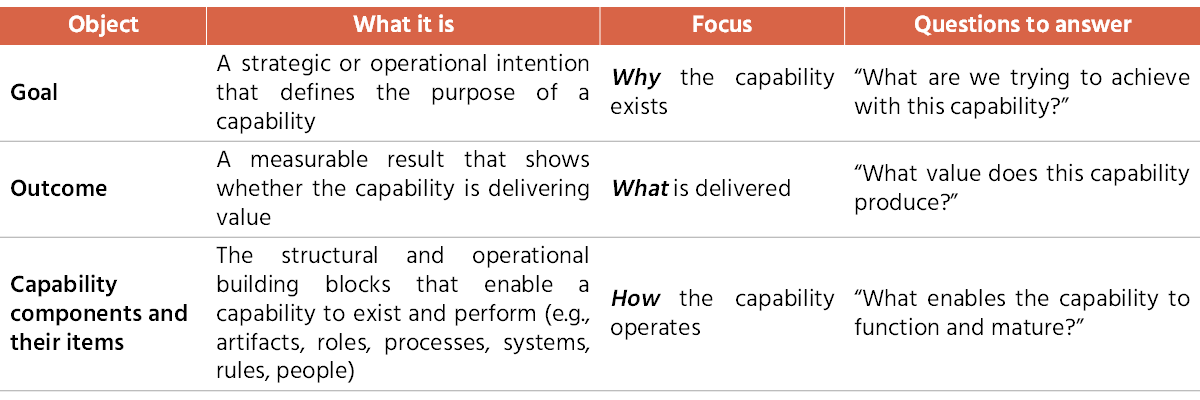
Table 1: Comparing the capability objects for maturity measurement purposes.
Comparing the Approaches of Industry Guidelines
This section briefly reviews how several leading industry guidelines define and measure data management maturity. We will examine the approaches developed by DAMA International (DAMA-DMBOK2), the Enterprise Data Management (EDM) Council through DCAM® and CDMC™.
DAMA International (DAMA-DMBOK2)
DAMA-DMBOK2 defines data management as:
The DAMA-DMBOK2 framework organizes data management into Knowledge Areas, and further defines their components using the DAMA Environmental Factors Hexagon. This model includes six elements grouped into three domains:
- People: Roles & Responsibilities; Organization & Culture
- Process: Activities; Techniques
- Technology: Tools; Deliverables
This Hexagon structure serves as the conceptual foundation for DAMA’s approach to maturity assessment.
When it comes to actual maturity measurement, DAMA-DMBOK2 recommends focusing on four of the six elements:
- Activities
- Tools
- Standards
- People and Resources
Although these categories do not align perfectly with all six elements of the Hexagon, the general principle is clear: DAMA-DMBOK2 suggests evaluating the components of each Knowledge Area as the basis for assessing maturity.
When compared to the O.R.A.N.G.E. Data Management Framework, DAMA’s approach similarly treats capability components as the primary criteria for measuring maturity.
Enterprise Data Management (EDM) Association
The EDM Association has developed two widely used frameworks: DCAM® (Data Management Capability Assessment Model) and CDMC™ (Cloud Data Management Capabilities).
The EDM Association glossary adopts the same definition of data management as presented in the DAMA-DMBOK 2. Both DCAM® and CDMC™ are structured around capability models; however, the glossary does not provide a formal definition of the term capability itself.
An analysis of publicly available examples suggests that these frameworks describe a capability primarily in terms of its objectives and artifacts.
Viewed through the lens of the O.R.A.N.G.E. Data Management Framework, this means that the EDM Association guidelines use capability components—specifically, artifacts—as the criteria for assessing maturity.
This reinforces a broader conclusion: the leading industry guidelines reviewed here—DAMA-DMBOK2, DCAM®, and CDMC™—all use data management capability components as the basis for measuring maturity.
Introducing the O.R.A.N.G.E. DMF Methodology for Measuring Maturity
This section provides a high-level overview of the methodology used in the O.R.A.N.G.E. Data Management Framework (DMF) for assessing the maturity of the data management capability. For a detailed explanation, readers are encouraged to consult the book The O.R.A.N.G.E. Data Management Framework.
Principle 1: Capability Structure and Granularity
The data management capability is structured as a set of interrelated capabilities, grouped into categories and supported by multiple sub-capabilities. To accurately assess overall maturity, it is recommended to measure the maturity of these lower-level capabilities and then aggregate the results to reflect the maturity of the holistic DM capability.
Figure 1 presents the DM capability model as defined by the O.R.A.N.G.E. DMF.
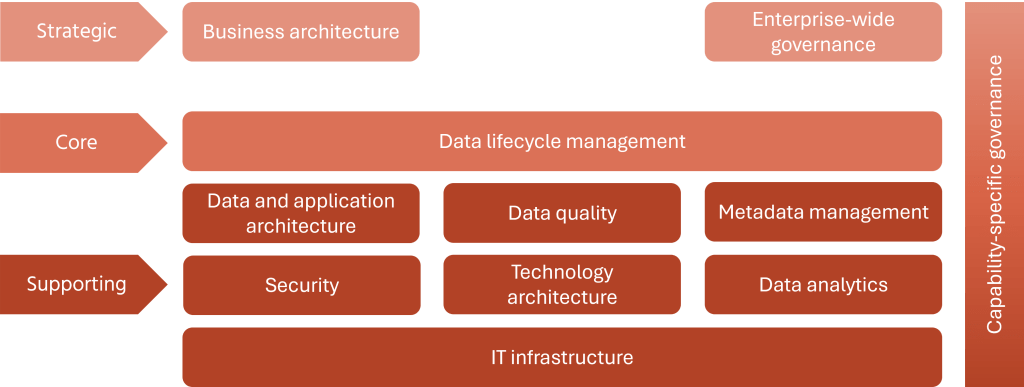
Figure 1: The DM capability model.
Principle 2: Organizational Levels of Maturity
The data management capability must be implemented and assessed across three organizational levels: strategic, tactical, and operational. The scope and content of the framework vary depending on the level, and so should the measurement approach.
- Strategic level: Maturity is measured for the overall capability based on its high-level goals and outcomes.
- Tactical level: Maturity is assessed for individual capabilities—such as data quality or data governance—using either outcomes or the maturity of all underlying components (e.g., processes, regulations).
- Operational level: Maturity is evaluated at the level of individual components and their detailed items. For instance, the “regulations” component may include multiple policies and standards that are assessed separately.
Figure 2 illustrates the DM capability across organizational levels.
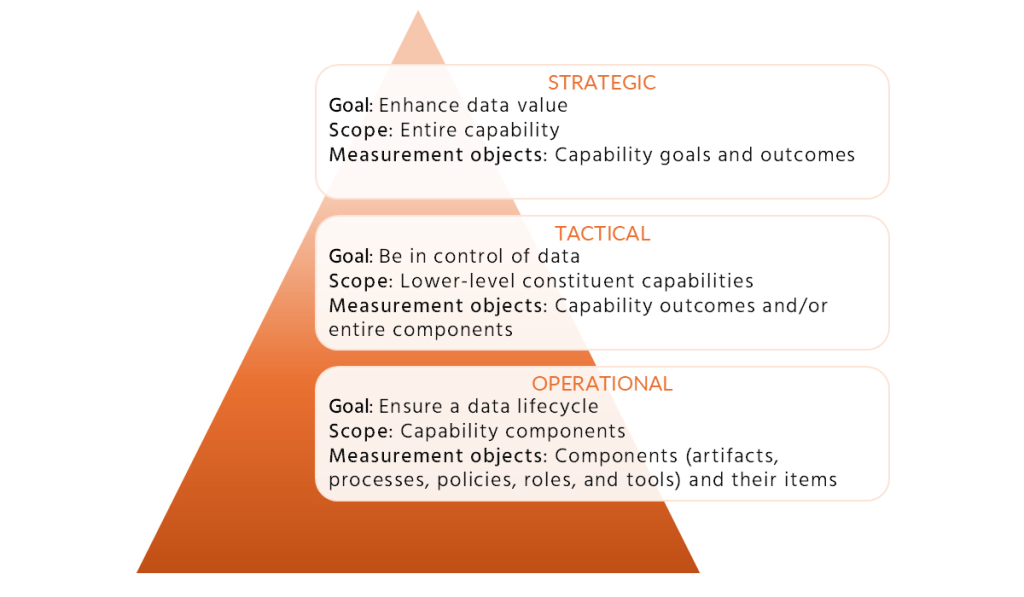
Figure 2: The DM capability across multiple organizational levels.
Principle 3: Methods of Maturity Assessment
Different organizational levels require different measurement methods. The O.R.A.N.G.E. DMF supports two complementary approaches:
- Simplified method: Based on a heat map approach and applicable at both the strategic and tactical levels.
- Detailed method: Required at the operational level and optionally at the tactical level. The results can then be aggregated upward to support strategic-level assessments.
Figure 3 illustrates both methods and their application at various organizational levels.
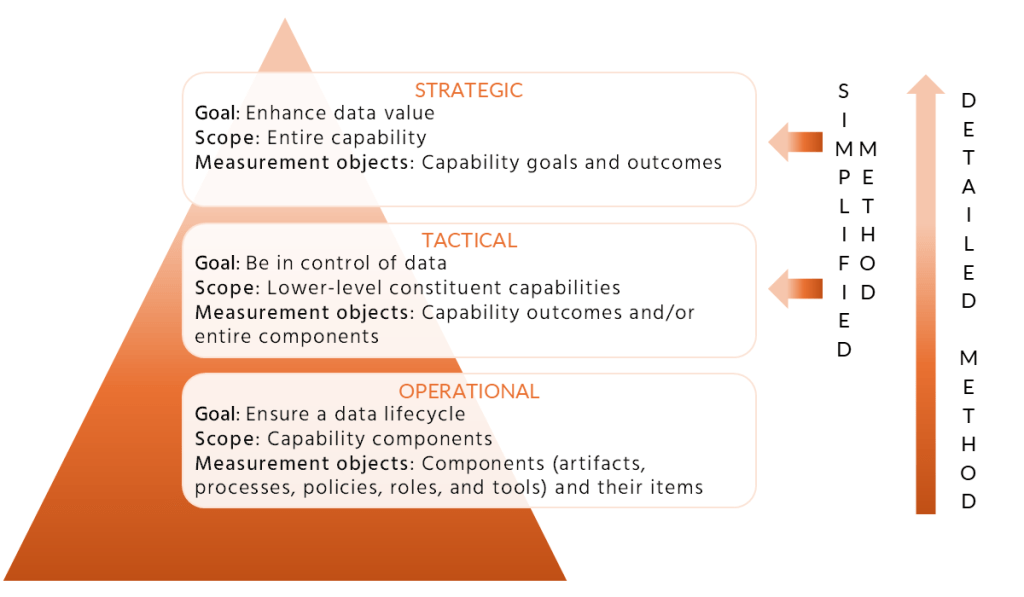
Figure 3: Methods to measure DM maturity at different organizational levels.
Organizations can choose between two assessment options based on the O.R.A.N.G.E. DMF methodology:
Option 1: Data Management Maturity Scan
Offered as a free, anonymous online service by Data Crossroads. This scan comprises 20 questions that cover the basic O.R.A.N.G.E. DM model and assesses outcomes for five core data management capabilities.
Option 2: Data Management Maturity Assessment
A paid consulting service that covers ten core data management capabilities. Organizations interested in a complete assessment can contact the author directly.
The maturity trends discussed in this article are based on Option 1 and reflect the results for the holistic DM capability, its four core components, and five foundational capabilities.
Maturity Trends
Trends in the Maturity of the Holistic Data Management Capability
Figure 4 illustrates the changes in data management maturity levels among organizations that completed the Data Crossroads Maturity Scan between 2020 and 2024.
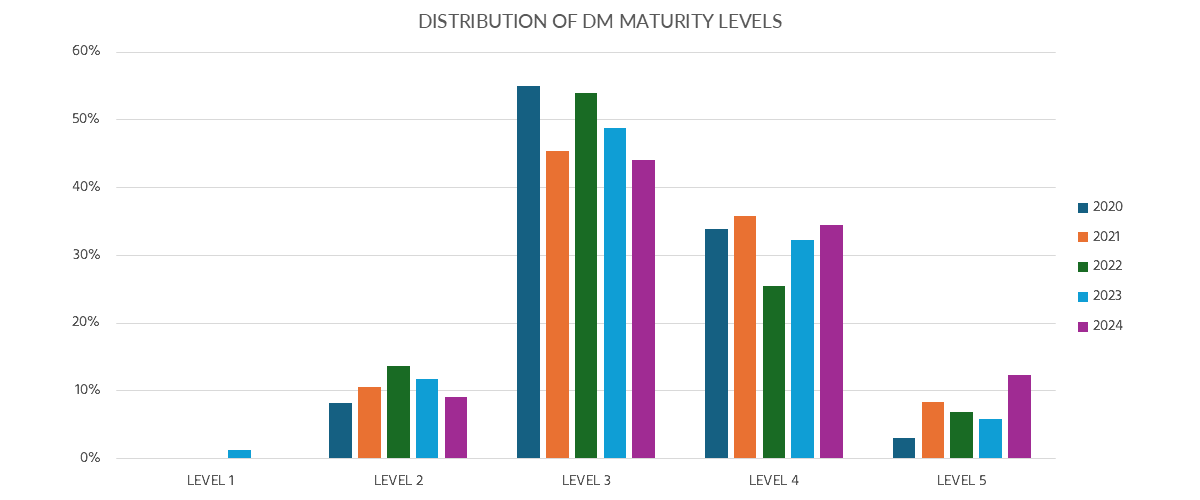
Figure 4: Trends in Data Management (DM) maturity levels among respondents.
The chart shows the distribution of data management (DM) maturity levels across five years of scan results. Level 3 remained the most common level of maturity throughout the period, although its share decreased from over 55% in 2020 to approximately 45% in 2024. This decline suggests that a substantial number of organizations advanced beyond mid-level maturity during this period.
Meanwhile, Levels 4 and 5 showed steady growth. In particular, the proportion of organizations reaching Level 5 more than doubled by 2024, reflecting broader advancement in data management practices and capabilities.
The percentage of organizations at Levels 1 and 2 remained relatively low and stable, indicating that fewer organizations are now in the early stages of developing their data management capabilities.
These trends indicate a general upward shift in maturity across the industry, with more organizations advancing to advanced levels of data management capability over the five-year period.
Trends in the Maturity of the Holistic Data Management Capability Components
Figure 5 illustrates the maturity trends of the four core components of the data management capability—Role, Process, Data (Artifacts), and Tool—between 2019 and 2024.
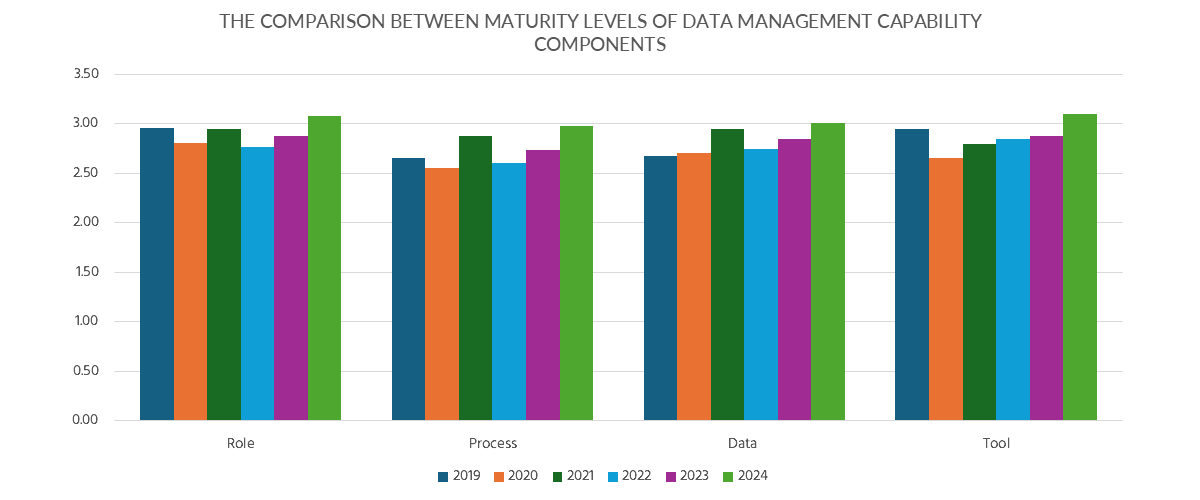
Figure 5: Trends in the maturity levels of the holistic data management capability.
The data shows that all four components have experienced gradual and consistent growth over the five-year period. By 2024, the Role and Tool components slightly outpaced the others, each achieving an average maturity level above 3.0.
In contrast, the Data (Artifacts) and Process components continued to improve but remained just below the 3.0 threshold. This suggests that many organizations have focused more on clarifying roles and implementing technological tools, while somewhat lagging in the formalization of data artifacts and the standardization of data-related processes.
Overall, the results indicate balanced progress across all capability components, with slightly stronger investment in roles and tools as enablers of data management maturity.
Trends in the Maturity of the Five Core Lower-Level Capabilities
Figure 6 presents the maturity trends of five core lower-level data management capabilities, tracked from 2019 to 2024.
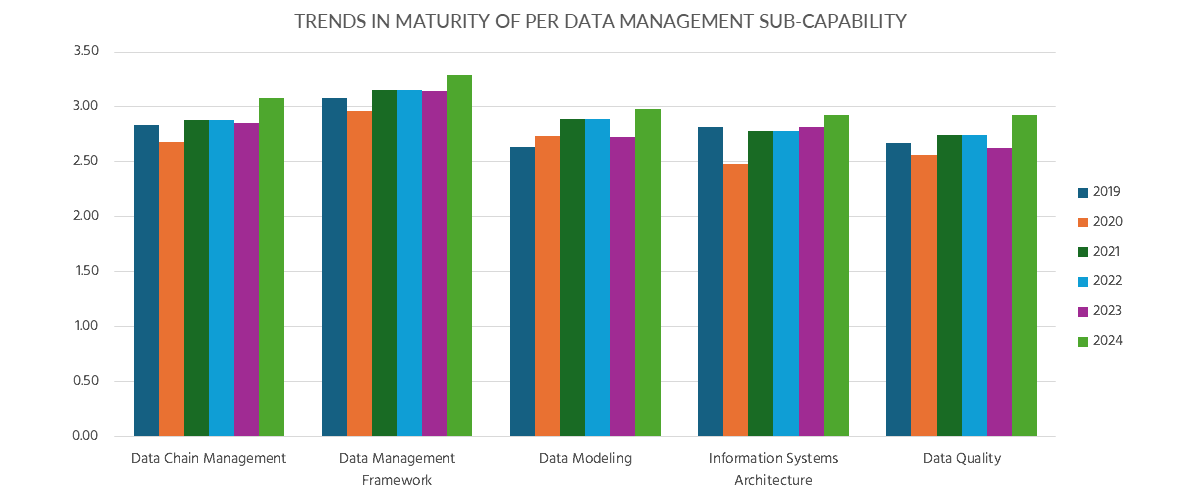
Figure 6: Trends in the maturity levels of the lower-level capabilities.
The data reveals a consistent upward trend in maturity across all five capabilities over the five-year period.
The data management framework and data modeling have maintained relatively high maturity levels, with steady, incremental improvements each year.
Information systems architecture and data quality began the period at lower maturity levels but have shown significant progress—especially in 2024.
Data chain management stands out for its dynamic growth, reflecting an increasing organizational emphasis on managing the full data lifecycle and improving lineage documentation.
These trends indicate a growing recognition of the value of foundational capabilities and an increasing focus on integration and traceability within the data ecosystem.
We will analyze in-depth the trends in each lower-level capability in the subsequent articles.
Recommendations
- Establish a clear definition of data management as a business capability
To assess and improve maturity effectively, organizations should adopt a structured view of data management that includes well-defined goals, outcomes, and capability components such as roles, processes, artifacts, and tools.
- Measure maturity at multiple organizational levels
Assess maturity not only at the strategic level but also at the tactical and operational levels. This multi-layered approach helps link high-level goals to practical execution and supports targeted improvement initiatives.
- Use capability components as primary measurement criteria
Align with leading industry frameworks by focusing on the presence and development of capability components—such as policies, standards, processes, and supporting technologies—as the foundation for maturity assessment.
- Prioritize balanced development across all capability components
While progress in roles and tools is evident, organizations should invest more in standardizing processes and formalizing data artifacts to achieve well-rounded data management maturity.
- Strengthen underdeveloped lower-level capabilities
Capabilities such as information systems architecture, data quality, and data chain management have shown improvement but still lag behind others. Prioritizing these areas can accelerate overall maturity.
- Select an assessment method aligned with your maturity goals
Use simplified methods (e.g., heat maps) for quick, strategic insights and detailed methods for in-depth operational evaluations. The choice of method should match the organization’s scope, needs, and readiness.


